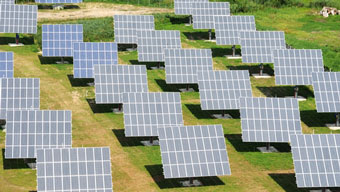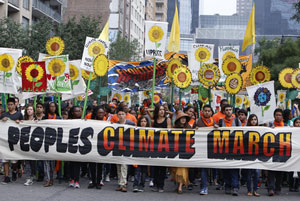Changeup on climate change
Bring Americans together to address climate challenges
President Donald Trump has yet to fully address the challenge of climate change despite strong signals of his intent to alter the current path. He has indicated that he could move in divergent directions on climate change. On the one hand, he selected an EPA administrator who directly targeted the Clean Power Plan while attorney general in Oklahoma; signed an executive order to dismantle the Clean Power Plan; and pledged to roll back aggressive vehicle fuel emission standards. On the other hand, in a postelection interview, he said that his mind remains open on the issue; he has met with Al Gore and other advocates of climate action; and his daughter—with a new office in the West Wing—has reportedly indicated her own interest in the topic. As he considers this choice of direction, Trump has suggested that he sees a trade-off between climate change action and economic growth. While California, China, and our national renewable energy sector tell a different story, economic arguments are not the only ones that favor strong action on climate change.
Trump has a great opportunity to rethink how Americans frame climate change.
The president can address climate change in the first year in a way that reaches across the aisle, speaks to all Americans, and brings us together. Although it may appear unlikely, Trump has a great opportunity to rethink how Americans frame climate change. He can ask the American people to place climate freedom above a narrow concept of liberty that has hobbled past efforts to implement climate solutions. Reminding us that the freedom to enjoy a healthy environment is one of our most basic freedoms, Trump can ask us to move forward, together, on climate.
Recommendations

Price Carbon
Given the brief timeframe during which our actions can make a difference on climate change, President Trump should follow the recent advice of former Secretaries of State George Shultz and James Baker and establish a price on carbon. Conventional wisdom says that a Republican president cannot embrace a carbon tax. This Republican president, however, has never deferred to the party and has made his name by doing things his own way. Conservatives have outlined the case for a revenue-neutral carbon tax, more palatable to Republicans than cap and trade, and thus more likely to succeed. In fact, over half of Republican voters support such a measure. A Republican Congress will have to wrestle with how to pay for Trump’s infrastructure plans. With that challenge, and their long-standing goal of paying for deficit reduction, a simple carbon tax (generating revenue to pay for infrastructure or deficit reduction) could promise both economic and environmental benefits. Americans want progress on both. At least half the voters from both parties support regulating carbon dioxide from power plants. A price on carbon could limit these emissions, even more efficiently than regulating state by state. More and more Americans want gas-saving, low-emission, or fully electric vehicles. A price on carbon can drive innovation and ensure that American auto companies produce the cars we want.
Engage the people
As a matter of principle, the president wants less climate action from federal agencies, but his principles also support working directly with the people. In fact, that is what he does best. The president can encourage individuals and businesses to take steps now toward a carbon-free future and to join in demanding action from friends, family, and communities; customers, suppliers, and competitors; and local, state, and national representatives. Americans are ready to make choices that will improve our climate future. The president does not need to do too much here—he simply must ask that we consider the possibility that climate change is real, remind us of some of the consequences, and make it easier for people to act. In reaching out to the people, the president must emphasize that acting to slow climate change does not bind us, but frees us in the most fundamental way, and guarantees freedom in the future.

Invest in climate insurance: Scientific and technological R&D
The president should increase—or at the very least maintain—spending on climate change science and technology research and development. Even if the president and his advisors remain uncertain about whether climate change is caused by humans, the possibility that it might be is good reason to take out an insurance policy. Much of this investment in long-term research and development will have infrastructure dimensions, from energy-efficient power systems and power transmission to clean-fuel vehicles. These investments help stimulate jobs here in the United States, which benefits American workers directly. Investments in engineering are needed to transform the way we generate, store, distribute, and consume energy. Advances in earth system science are needed to understand and adapt to the impacts of a warming world and to evaluate the pathways still open for mitigating climate change. At present, the federal government spends as much every year on clean energy and climate change research as it does on cancer. Twice as much was invested—for 14 years—to put a man on the moon, and our current space programs continue to receive this level of investment. The federal budget for all research on human health is six times as great as our investment in research to alter the course of climate change. To ensure human health and well-being in the coming decades and beyond, a greater investment in energy research is necessary. Voters of both parties support making the investment.
A price on carbon will ultimately spur private investment in research on zero-carbon energy systems, but achieving that goal may take time. Meanwhile, federal investment in research at national labs and universities can yield early gains. Federally funded research has historically delivered critical advances that solve problems for the nation and the world while driving economic growth. Direct engagement with the public, harnessing the power of social networks including the president’s, will provide support for the investments and policy needed to address climate change. An engaged public may also prove more capable of adapting to the climate impacts we do not manage to avoid.
Context
We do believe in global warming, but we don’t believe in our government
Consensus about human-caused global warming is incredibly high among climate scientists. Most American voters, however, are not aware of the level of agreement among them. Even without the knowledge that they are firmly backed up by the scientific community, two- thirds of Americans are mildly or very concerned about climate change. For the first time ever, over two-thirds believe that humans are responsible for the warming. The people, including voters from both parties, are ready for action to limit climate change. However, climate change is not their highest priority. And unfortunately, on climate, Congress does not reflect the opinions of the people. Trump must work to unlock the power of high levels of agreement among Americans to overcome resistance in Congress.

Inspiring the people will be a challenge. In addition to what appears as partisan bickering, continued economic difficulty, rising income inequality and associated disparities in sense of security, access to opportunity, and overall well-being are driving strong rhetoric on both the right and the left, underlining dissatisfaction and calling for dramatic change in our government and our society. The president has an opportunity, and an obligation, to address this desire for change. Climate change can be a strategic focal point for reframing the relationship between the people and their government and between individuals and the nation as a whole.
Framing
Climate freedom
To make the most of bipartisan popular support for action on climate change, the president has an opportunity to counter the most powerful, visceral arguments against climate action. These arguments frame carbon dioxide regulation as an infringement on freedom—to drive any size car as much as we want, heat and cool our homes as we desire, leave the lights on, and run all our appliances and electronics whenever we wish. But in fact, that freedom is not at issue. The use of fossil fuels to provide the required energy is at issue. The president must ask, again and again, “Whose freedom is at stake? To do what?” Republicans and Democrats joined years ago to deny the freedom to pollute, because pollution is an infringement on the liberty of all. Freedom to live in a healthful environment, with diverse and productive landscapes, living oceans, and a climate that sustains us is the most basic of freedoms. That is the freedom at stake. The president must remind us that we are striving to preserve the freedom for our children to play outside—and for adults to work outside—in the summertime; for parents to spend hard-earned money on groceries, a cell phone, an Internet connection, a safer apartment, or college rather than air conditioning, emergency room visits, or flood repairs. Salvaging lives upended by climate change will be devastating and expensive for families. For the nation, rolling recoveries will be at best expensive and wasteful, since we could have avoided the damage. At worst, they will be tragic. Some losses, in human life and livelihoods, cannot be made whole.
Carbon pollution . . . is the most deadly pollution we have ever faced.
Carbon pollution, seen not in the air but in rising seas, higher temperatures, heavier downpours, and animals, plants, and diseases moving north, is the most deadly pollution we have ever faced. The new president’s own real estate companies acknowledged this in their application for a sea wall to protect one of their premier golf courses.
The Supreme Court has affirmed treating carbon dioxide as a pollutant; that debate is in the past. The real question is: How shall we deal with a type of pollution that is at the core of everything we do? Aside from trees and seagrasses, which grow too slowly and not at a scale to meet all our needs, we lack affordable technology to contain or clean up carbon pollution. And so, we must stop polluting.
Choice, liberty, and privacy
The president must use new tools to stop carbon pollution. President Barack Obama took many important steps, but also revealed the limits of executive action. If Congress is not ready to put a price on carbon, the president should engage the public, asking for our personal commitment not only to do what we can to reduce greenhouse gas emissions, but also to pressure our elected representatives to do more. The president must ask us to make the decisions that lead to a better climate future.

People make choices every day, and even without a price on carbon, we could change our behavior. Consider: We don’t litter. We don’t smoke in enclosed public places. Our children are shocked if we don’t recycle. Why should we waste energy? With many of us deeply embedded in social networks and most connected by electronic media, peer pressure could play a powerful role in changing attitudes toward energy conservation and energy efficiency. Attracting the younger generation, who place a higher value on the environment, should not be difficult. Younger Americans can “manage up,” influencing their parents, relatives, and bosses. We are all subject to the judgment of peers, community, and the people we admire. The president, with 20 million followers on Twitter, is well-placed to harness the power of social networks, enlisting thought leaders, religious leaders, trendsetters, beloved figures, and everyday people in a campaign to make wasting energy as socially inappropriate as littering.
Using less energy, however, will not drive an energy revolution. A carbon price is still required to level the playing field for zero-carbon energy sources, and thus to alter the choices of individuals and businesses alike. With a carbon price to account for the full cost of carbon pollution, consumers would choose climate-friendly goods and services simply because they would be cheaper relative to those produced with fossil fuels. At least initially, they may pay a higher price, because the price of energy could increase in some markets. As a consequence, consumers will be motivated to reduce energy consumption and will clamor for new ways to do so. The president cannot reshape our suburban landscapes and transform public transit in his first year; longer-term efforts are required to save energy in the transportation sector. In the first year, however, the president can work with electric utilities to increase the choices available to consumers for saving energy in homes, offices, and other buildings, including removal of barriers to rooftop solar.

The president will have to work with ordinary citizens as well as the utilities. Some of the biggest gains may come from technology that forces us to redefine our notion of privacy and freedom. Already, technology allows utilities to cut power periodically in exchange for lower electricity rates. The technology can be applied to household devices like refrigerators, water heaters, dryers, air conditioners, or heat pumps as well as industrial machinery, condensers, or commercial lighting. At present, the utility decides when to cycle power on and off, and from a consumer perspective, this demand response system is “opt in.” More electricity would be saved if customers could dial up the frequency of turning off power. Participation would be much greater if customers were required to “opt out.”
Advanced monitoring and metering technology could enable further gains, if customers were willing to use it. Imagine if our phones told our houses when we left for work, or moved from room to room, and turned systems on or off as needed. Even more energy and cost savings would follow if data on electricity use were shared with neighbors, as occurs already in some markets. We love to compete, especially to do the right thing; when we do, we reduce energy consumption. Many Americans resist the idea of monitors in our homes and phones that report our location. We do not like the idea of sharing our data with neighbors or anyone else. Yet in an era when Facebook tailors our news, Google customizes our ads, Amazon suggests products, and our phones direct us to the nearest gas station, fear about the privacy of our electricity consumption seems misplaced. Electricity generation is the largest source of emissions in the U.S. Until we have carbon-free generation, the president needs to use all tools available to reduce demand for electricity.
For many, the issue is not privacy alone, but control. How much are we willing to give up? We already let others drive us by bus, subway, taxi, or Uber. Can we sit in a shared, driverless vehicle for gains in fuel efficiency? Eliminating the steering wheel may be more likely if we identify climate gains as just one benefit in addition to higher air quality, reduced congestion, a shorter commute, and increased urban space. That technology is not as far off as we think. Many technologies already exist that promise great gains for the climate, but some require us to rethink what freedom means. The intersection of climate change and technology is not unique in this realm; many of the technologies that already give us so much also demand a rethinking of choice, liberty, privacy, and freedom.
We have an obligation to switch away from fossil fuels, and we can.
With climate change, the greatest freedom is at stake: the freedom to live in a familiar world. The peril is not only for our children and grandchildren and their grandchildren. We too will feel the impacts of a much warmer world unless we remake our energy system. We have an obligation to switch away from fossil fuels, and we can. With the obligation comes an opportunity to remake our world rather than merely survive it. That is freedom. But it will not be ours if President Trump waits to put a price on carbon, invest in clean energy and climate science, and engage the public in climate solutions.